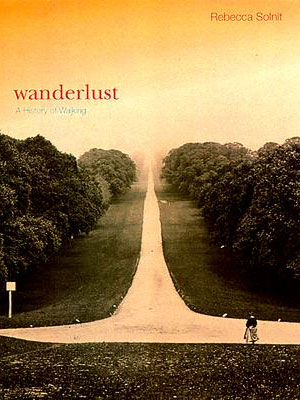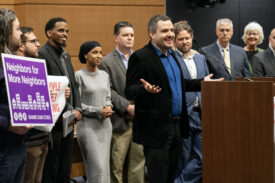Dear Ms. Solnit,
This is fan mail, I swear. Before I get to the gushing, though, I need to tell a circuitous tale.
I went to Las Vegas last summer. I went for work, but I had an auxiliary mission: to find the city’s redeeming value, its hidden virtues, its inner humanity. I failed.
Granted, I only had a couple of hours away from the conference I was locked in at Caesar’s Palace, so all I could do was walk The Strip in the broiling sun and keep an eye peeled for epiphanies. Sadly, all I saw was shallowness and greed on a Messianic scale. I left for the airport disheartened by my walk.
(By my business in Vegas, I was left anything but disheartened. The activist in you would have been as excited as I was to participate in a gathering of reformers intent on building new organizational forms of political power for working people in the vacuum left by a declining labor movement. The organizer, master strategist David Rolf of the SEIU, has now published the conference’s call to action in The Nation.)
I’ll be passing through or near Las Vegas again soon. (I’ll be en route to a family reunion in the only non-Cascadian place that figured prominently in my childhood. It’s in New Mexico, where you once lived. Unusually, for me, I’ll be driving. One of the ironies of raising children without a car, as I’ve been doing these last eight years, is that it’s hard to teach them to drive. The car-sharing companies I rely on do not tolerate student drivers, nor do rental car companies, so we’re borrowing a car and taking a road trip. That way, my license-less 20- and 21-year-olds can get many hours of practice at the wheel.)
Our route will take us across first our home region of Cascadia and then the Great Basin, the bioregion neighboring ours to the south. Immortalized by John McPhee, it is Cascadia’s opposite. Dry to our wet, brown to our green, and landlocked to our ocean-fronting, it has rivers that flow inward to dry washes and salt lakes. It is, consequently, devoid of the salmon that define and literally feed Cascadia’s watersheds. The Great Basin’s proximity and difference make it seem important to me, just as my neighbor’s garden looms large when I look at my own. At the center of the Great Basin, of course, is Las Vegas. In most ways, Vegas is the opposite of Cascadian cities: flashy and self-aggrandizing to our fleecy and retiring. Yet I still yearn to find the commonality between it and the places I visit and advocate for as a profession and a calling.
Earlier this year, a conversation about Las Vegas with a friend who knows well the literature of place ended up in two assigned readings for me. The second is your book Wanderlust. I’ll get to that in a moment. First, though, I read Ellen Meloy’s essay “Flora and Fauna of Las Vegas” in this anthology. Meloy’s essay recounts a visit to the city to see where the waters of the Colorado River end up, removed as they’ve been from her valley in Utah. She writes with intense beauty and scathing authenticity about the depleted, irradiated, electrocuted wildlife—human and animal—of Vegas. Her writing is incandescent. It is not, however, redemptive. She did not help me find the good news in the city. A taste:
At the Nevada state line we cast aside Utah’s wholesome aura for its nemesis. Behind: Leave it to Beaver. Ahead: Sodom and Gomorrah. In dusk that sizzles at 103 degrees, the land sprawls . . . Over a long rise, past a convoy of trucks afloat in mirages of diesel and heat, we top the crest of the final ridge and behold the valley below, an island of neon capped in sludgy brown smog, ringed in a rabid housing boom. Las Vegas. The Meadows.
In fact, her essay reminded me of Annie Dillard’s book The Living, which I reflected on last year. Meloy’s style is biting and marinated in irony. Dillard’s is not. The Living is earnest, its writing so well crafted that you want to re-read some of the sentences five times just to feel them melt on your tongue again and again. But—Lord—the darkened sadness of it! That’s where Meloy and Dillard align. The underlying message is stoic, if not tragic.
What I loved and recognized in Meloy was not how she described Las Vegas, though. It was how she talked, in brief asides, about the Desolation Valley she came from, in southern Utah on the Colorado Plateau: the place where the Colorado River water was supposed to be but wasn’t any longer. As I read about her parched valley, I recognized the sentiment, despite the contrast in precipitation.
It reminded me of my favorite ode to the Northwest, Sam Hamill’s “A Lover’s Quarrel.” A taste:
Don’t tell me
about the seasons in the East, don’t talk to me
about eternal California summer.
It’s enough to have
a few days naked
among three hundred kinds of rain.
Ellen Meloy went to Las Vegas to look for her water. She found it, of course. She found basically nothing else to admire. I would have to seek a kinder vision of The Meadows elsewhere. I found it, Ms. Solnit, in your 2001 Wanderlust: A History of Walking.
What a remarkable book! More than 300 pages of intellectual, social, and political history of walking. I’d have thought there wouldn’t be much to say, that a history of walking would be as tedious as a history of chewing. But you searched all of Western art, history, and literature, some social and natural science, plus strands of thought from other cultures and civilizations.
From the very opening, where you describe how walking upright on two legs may have been decisive in sculpting human nature, I read with my jaw hanging open (metaphorically, I hope). You guided me down countless paths: the Ancient peripatetic philosophers, the way the European gentry built gardens and galleries for walking inside their walls, the growth of formal gardens and sculpture gardens, Wordsworth and the Romantics and the nature-idolizing legacy they left, the emergence and disappearance of popular pleasure grounds, of urban shopping streets and arcades, the radical political roots of Europe’s working-class walking clubs, the fight for the right to walk on private land in the countryside in Europe and to keep public land public in North America, European women’s fight to be able to walk outside at all without arrest for prostitution or ostracism from polite society. You tramped me through the histories of treadmills and labyrinths, of pilgrimages and walking meditation, of the country ramble, the mountain hike, and the urban exploration. Along the way, you introduced the great walkers, the great writers of walking, plus cranks and eccentrics long forgotten. By the end, you’d essentially laid bare the social meaning of walking in the West and how it has changed through the ages.
Wanderlust is impressively learned, deeply textured, and varied, too. “I like walking because it is slow,” you write, “and I suspect that the mind, like the feet, works at about three miles an hour.” That’s how you paced your story. It moved at exactly the speed I could absorb, unrushed.
So when, at the end of all the wonders of the literary walk, you arrive in Las Vegas, I was on tenterhooks. What would you say about the city I hate but long to understand and sympathize with?
Where Meloy and I failed, you succeeded. Without romanticizing Vegas, you managed to transform its meaning, by reference to walking. The Strip, you explain, has been steadily, inexorably transforming itself from highway to promenade. It is, indeed, now one of the United States’ most-walked streets. Throngs migrate up and down, taking in the tawdry light shows and pirate-stripper theatricals and gawping at the absurdist replicas of wonders of the world. If you peel away the cultural residue of the present moment: mass consumer capitalism (sexual titillation, something-for-nothing-ism, debt-financed forced revelry, faux egalitarianism), The Strip is a more-or-less perfect reincarnation of the birth places of pleasure walking in Europe.
The Strip is replacing its neon-go-go Americana futurama vision with Europe, a fun pop-culture version of Europe, a Europe of architectural greatest hits and boulevardiers in shorts and T-shirts. Is there anything less peculiar about setting miniature Italian and Roman temples and bridges in English gardens than in putting up gargantuan ones in the desert, in building volcanoes in eighteenth-century gardens such as Wörlitz in Germany than on boulevards in Nevada? Caesars Palace, with its dark green cypresses, fountains, and classical statuary out front, calls up many of the elements of the formal garden, . . . . Bellagio, with its frontage of fountains, recalls Versailles . . . . These places are mutant reprises of the landscapes in which walking as scenic pleasure was developed.
So just as conventioneers and vacationers by the millions travel to Cascadia to walk our great parks, to stroll the Pike Place Market or Granville Island, to poke around, often on foot, in search of moments of distraction or insight or laughter, so too do they go to the capital of the Great Basin: a giant dryland with no exit to the sea, inward-focused and hydrologically sealed off, hidden-away almost, with Vegas at its center.
And in Vegas, what do they do? Among other things, they walk. The city’s designers originally intended them to drive, and they do, of course. But they also, like I did, walk The Strip. Designers had to accommodate this urge, because visitors were doing it anyway.
And now, I understand this fact, thanks to you, Rebecca Solnit. That’s why I am such a fan. You found what Ellen Meloy and I could not. You found what’s to love about Las Vegas.










Car-free Lady
I tried living in Las Vegas for a month, a couple of years ago, just to experience its fledgling sustainability life-style that I’d been hearing about from some environmentalists. I was pleasantly surprised at the relatively good bus system they have there! I completely avoided The Strip (it’s just not my thing), but your article makes me curious about it now! Thanks!
stephen antupit
For a very different experience of Las Vegas, consider making Downtown a side trip or an alternative destination. To prep my recent Pecha Kucha presentation, I did just that: went the full AirBnB route, dabbled with Vegas-caliber optimism of tech start-ups, and (no surprise) made the most genuine connections with the local Burning Man denizens and their engaging community art project.
Car-free Lady
[Alan, I just read the article you linked to in “The Nation” regarding the purpose of your business trip to Las Vegas.
Wow, that is something I am hugely interested in. I work part-time for a world famous fast-food restaurant. My meals are not free even on the days I am working there. Yes, they give me a discount… But, this multi-billion dollar industry is still charging me, their employee, to eat there! Today I signed up for food stamps because, on minimum wage, I can’t afford food after paying rent.]